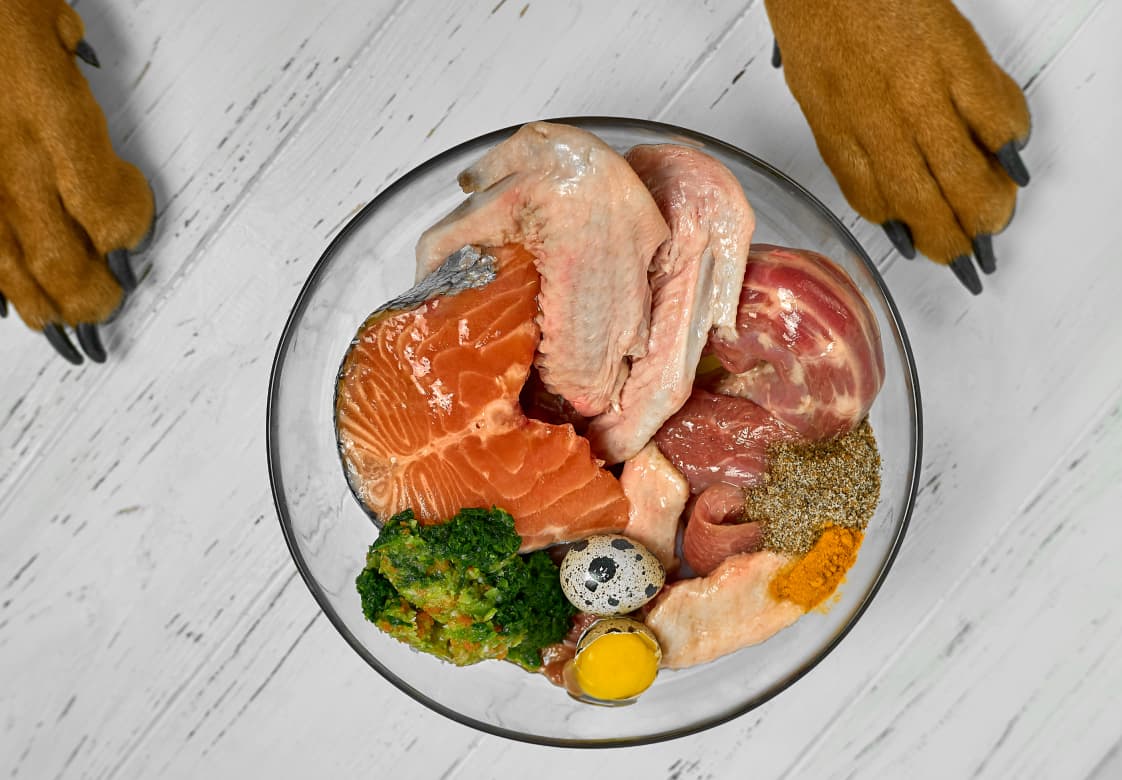A puppy’s diet is a very dense topic surrounded by many myths. So how do you feed a puppy correctly? And does a puppy’s diet differ from that of an adult dog?
Puppy Energy Demands
The highest demand in energy the puppy experiences is during the growth period, as it is growing intensively and needs a lot of nutrients and minerals. This should be taken into account when planning the puppy’s diet. In the first few days after the puppy is taken from its mother, his weight is small but the growth is intensive. 50% of his energy is spent on maintaining daily activities while 50% is used for growth.

When the puppy has reached 80% of its full weight, 8-10% of energy is spent on growth. At a certain age, there comes a point when the energy consumed does not increase. For instance, for German Shepherds (whose approximate weight in adulthood is 35 kg), this moment comes at the age of 4 months. But this is, of course, not a general rule as all German shepherds are different.
From the moment of separation until the time they gain 50% of their adult weight, puppies need 25 kcal per 100 g. When the puppy has gained 80% of its eventual weight, its demand in energy is like that of an adult dog. But keep in mind that any formula is a measure based on averages.
Large and giant breed puppies are recommended to have a lower amount of energy as they are predisposed to musculoskeletal apparatus diseases. Choose a low-calorie kibble from the moment the pup is at home as a high-calorie diet can lead to excessively intensive growth and be dangerous.
Obesity prevention should begin from the moment your pup is separated from his mother. With a normal diet, the puppy will automatically gain the weight to which he is genetically predisposed. It’s better not to speed up this process.
Puppy Diet: Protein
A puppy needs protein as soon as it is taken from its mother. This demand is usually compensated for by a proportionately larger amount of food.
Most ready-made food contains enough protein – a minimum of 22% raw protein required at 80% digestibility. This is a minimum to focus on.
The hypothesis that a high protein level is bad for the puppy’s musculoskeletal system has not been confirmed.
A high protein level is safe for the puppy’s development, so there’s no need to limit it at any stage of growth.
But if the puppy’s diet includes only meat which is not supplemented with any mineral substances, particularly calcium, it may damage the musculoskeletal system formation process.
Puppy Diet: Fat
Fat is the main energy source for puppies. A puppy’s food should include not less than 5 – 10% of it. If the content is less than 10%, it is necessary to supplement it with a high content of essential linoleic acid (vegetable oils except olive) and omega-3 (fish oil).
Puppy Diet: Calcium and Phosphorus
Puppies need a large but not an excessive amount of calcium and phosphorus:
- For large breeds: 0.7-1.2% calcium (content in food)
- For small breeds: 0.7-1.7% calcium (content in food)
- 0.35% of phosphorus (content in food)
An adult dog’s need for calcium and phosphorus always varies and requires regulation.
An excessive amount of calcium and phosphorus is as bad for them as a lack thereof because puppies of 2-6 months don’t have regulated calcium absorption. Calcium absorption stabilizes by the age of 10 months, but growth troubles, if the puppy is predisposed to them, would already be revealed.

Moreover, excessive calcium can damage the puppy’s musculoskeletal system formation and may lead to problems with calcium absorption in the future.
To avoid any problems, follow dietary rules carefully.
Puppy Diet: Carbohydrates
A healthy dog doesn’t really need carbs, so there are no particular rules for them. However, they are an alternative source of energy and almost no dry kibbles are free of them. A carbohydrate content of 20% in the food is enough for 4-month old puppies.
If feeding with homemade food, carbohydrates are unnecessary if the puppy eats high-quality proteins and has no troubles with digestion.
When feeding high protein and high fat food with fewer carbs, more fat tissues are formed.
Puppy Diet: Zinc
In the first months, the puppy’s demand for zinc is high. It should be provided according to the norm. Keep in mind that high amounts of calcium and phosphorus interfere with zinc absorption.
Puppy Diet: Copper
The puppy’s demand for copper should be covered according to the norm. A hard-to-digest form, copper oxide, which is used in some kibble, is not to be taken into account as it’s only a colorant.
A lack of copper may result in the loss of pigment when, for instance, dark fur becomes grey. An extreme lack of copper leads to elongated fingers and anemia.
Puppy’s Dietary Norms
| Factor | Amount in food | |
| Adult dogs less than 55 lb | Adult dogs more than 55 lb | |
| Energy kcal | 3,5 – 4,5 | 3,2 – 3,8 |
| Energy kj | 14,6 – 18,8 | 13,6 – 15,7 |
| Crude Protein % | 22 – 32 | 20 – 32 |
| Crude Fat % | 10 – 25 | 8 – 12 |
| Calcium % | 0,7 – 1,7 | 0,7 – 1,2 |
| Phosphorus % | 0,6 – 1,3 | 0,6 – 1,1 |
| Ca / P | 1:1 – 1,8:1 | 1:1 – 1,5:1 |
Weight Control for a Growing Puppy
Small and medium breeds (up to 25 kg) reach 50% of their weight by four months. Large breeds (over 25 kg) – in 5 months.
You can easily find puppy growth charts on the Internet. Enter your puppy’s breed, age and height and check how compliant it is with the specified standard. However, keep in mind that the information is not very precise as these charts are at the experimental stage and may differ from one another.
To calculate the average weight of a puppy, you can use the following table:
| Adult dog weight (lb) | 11 | 22 | 44 | 77.1 | 132 |
| 1 month (in the middle) | 1.1 | 1.5 | 2.4 | 3.3 | 4.6 |
| 2 months | 2.6 | 4.1 | 6.8 | 10.3 | 14.5 |
| 3 months | 4.1 | 7.2 | 13 | 21.1 | 29.1 |
| 4 months | 5.7 | 10.5 | 19.62 | 31.9 | 44.9 |
| 5 – 6 months | 7.7 | 14.3 | 26.8 | 44 | 66 |
| The end of 6 months | 8.8 | 16.5 | 30.8 | 50.7 | 79 |
| 12 months | 11.02 | 20.9 | 41.8 | 68 | 105 |
These are average figures.
Methods of Feeding the Puppy
There are several methods of feeding puppies, and each of them has its pros and cons.
| Feeding Method | Pros | Cons |
| Free access to food |
|
|
| Portion feeding with a daily norm restriction |
|
|
| Portion feeding with a time limit |
|
|
When the puppy is in a fast-growing phase, it is better to refrain from free and time-limited access to food. Studies have shown that puppies who were fed twice a day for 20 minutes had more weight, more body fat and increased bone mineralization, as did puppies with free access to food.
The best method: accurately measured amount of food, divided into 2 – 4 feedings (depending on age).
Disorders Caused by Improper Feeding of the Puppy
As a rule, we are talking about digestive disorders which may be caused by the following: eating bones or fiber (for example, if parts of wooden sticks are swallowed when playing), consumption of lactose and “heavy” proteins (for example, tendon bones or innards). All of these can cause diarrhea in the dog.
